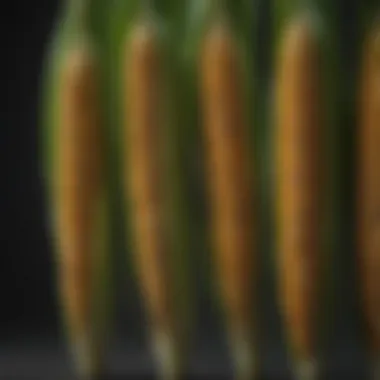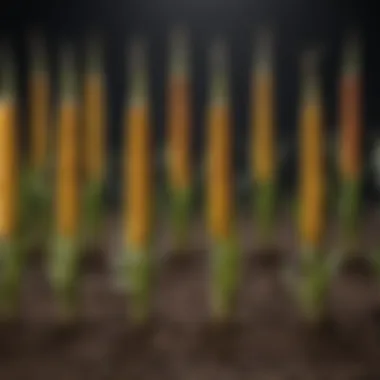Understanding Corn Seed Spacing: A Comprehensive Analysis


Intro
Corn is a significant crop globally, serving as food, feed, and biofuel. Understanding how to optimize corn seed spacing can influence yields drastically. Proper spacing impacts plant growth, nutrient uptake, and ultimately the quality and quantity of the harvest.
Seed spacing calculators emerge as essential tools in this context. They help farmers make informed decisions based on various agronomic factors, leading to better crop management.
This article will present a thorough examination of corn seed spacing, exploring its biological principles, the factors that affect spacing choices, and how calculators can facilitate optimal practices.
Preface to Corn Seed Spacing
Corn seed spacing plays a crucial role in crop production, influencing not only yield but also overall plant health and resource use efficiency. Understanding how to optimally space seeds can lead to healthier plants that are better equipped to withstand environmental stresses. This article aims to delve into the complexities of seed spacing, offering insights into its historical context, biological underpinnings, and practical applications.
The key benefits of proper seed spacing include increased access to sunlight, nutrients, and water for each plant. When seeds are too close together, plants may compete for these essential resources, which can lead to stunted growth and lower yields. Conversely, excessive spacing may leave land underutilized and reduce potential output. Therefore, finding the right balance is essential for maximizing crop production.
The Importance of Seed Spacing
Seed spacing is vital in achieving optimal plant development. Several critical factors underscore its importance. First, evenly spaced seeds reduce competition for resources among plants. When seedlings are spaced appropriately, each plant has a better chance to grow strong and healthy. This can be reflected in higher crop yields, which is the ultimate goal for farmers.
In addition, proper seed spacing can enhance pest and disease management. Well-ventilated rows allow for better air circulation between plants, which can reduce the risk of diseases that thrive in crowded environments. A well-planned seed arrangement can also help in monitoring plant health throughout the growing season, making it easier to identify issues that may arise.
Moreover, seed spacing should also be informed by specific farming practices and regional conditions. Farmers need to consider soil fertility, expected rainfall, and climate variations when establishing their row spacing and seed distributions. This nuanced approach can lead to improved adaptability in changing weather patterns and fluctuations in agricultural demands.
Historical Perspectives on Seed Spacing
Historically, corn cultivation has evolved significantly, and so have the methods of seed spacing. Early agricultural societies relied heavily on trial and error to determine proper spacing. Ancient farmers planted seeds by hand, relying on their instincts and observations to gauge effective distances.
With the advent of mechanized agriculture, practices have shifted. The introduction of seed drills allowed for more precise and consistent seed placement. Over the years, extensive research has been conducted to quantify the effects of different planting densities and spacings. The combination of historical practices and contemporary research has paved the way for the advanced calculators and modeling tools available today.
In recent decades, agricultural science has focused on optimizing seed spacing for various corn hybrids and conditions. Ongoing trials continue to refine these practices, emphasizing the need for data-driven decisions in farming. Farmers today can draw insights from the successes and failures of past methods, compelling them to look towards sustainable practices that honor both tradition and innovation.
Biological Factors Influencing Seed Spacing
Understanding the biological factors that influence corn seed spacing is crucial for maximizing growth and yield. These factors play a significant role in the success of a corn crop, impacting everything from soil nutrients to plant competition. Recognizing and analyzing these variables allows growers to make informed decisions that align with optimal agricultural practices. In a world increasingly focused on sustainable agriculture, knowing how biology intersects with technology becomes essential.
Soil Types and Their Impact
Different soil types carry distinct physical and chemical properties that directly affect seed placement. For instance, sandy soils drain water quickly but may not retain enough moisture for seeds to germinate effectively. In contrast, clay soils retain moisture but can lead to poor drainage, potentially harming roots.
- Moisture Retention: Sandy soils may necessitate closer seed spacing to ensure plants have sufficient moisture.
- Nutrient Availability: Loamy soils, considered ideal for corn, usually provide the best nutrient balance.
- Soil Structure: The presence of organic matter contributes to soil health, influencing how corn plants spread their roots.
Farmers must evaluate their field’s soil profile before deciding on seed spacing. This evaluation will not only improve seedling survival rates but also increase overall crop productivity.
Crop Variety Considerations
Choosing the appropriate corn variety is essential to effective seed spacing. Various hybrids respond differently to spacing due to growth habits, resilience, and nutrient requirements.
- Growth Rate: Faster-growing corn hybrids can benefit from wider spacing, allowing for better air circulation.
- Plant Height: Taller varieties may require closer spacing to maximize sunlight absorption without shading other plants.
- Disease Resistance: Stronger varieties may tolerate closer planting, while more susceptible types may require wider spacing to reduce disease proliferation.
Selecting the right variety can optimize utilization of available resources and contribute to healthier crop development.


Climate and Environmental Effects
Climate is a vital component when assessing corn seed spacing. Various climatic conditions impact growth patterns and ultimately yield.
- Temperature Fluctuations: Warm temperatures promote quicker germination rates, but excessive heat may hinder growth. Proper spacing could mitigate temperature-related stress among plants.
- Precipitation: Regions with heavy rainfall may see certain advantages in closer seed placement to prevent poor root growth due to oversaturation.
- Sunlight Exposure: In areas where sunlight is plentiful, closer spacing can enhance the use of available light. Conversely, in shaded areas, wider spacing can prevent competition amongst plants.
Understanding how climate variables interact with each other and with specific crops fosters a more nuanced approach to seed spacing and overall management strategies.
Understanding the Corn Seed Spacing Calculator
Understanding how to utilize corn seed spacing calculators is vital for enhancing agricultural efficiency. It involves an integration of various factors that affect seed growth, overall yield, and farming practices. The use of these calculators empowers farmers and researchers to make informed decisions about how to space seeds optimally, resulting in efficient use of land and resources. By applying a systematic approach to spacing, significant improvements in crop production can be achieved, fostering sustainable agricultural methods.
What is a Corn Seed Spacing Calculator?
A corn seed spacing calculator is a tool designed to assist in planning the optimal distribution of seeds within a given area. It utilizes specific input variables, such as row spacing, seed size, and desired plant population, to calculate the most efficient seed spacing. This tool is fundamental in precision agriculture, as it helps in maximizing yields while minimizing costs.
The primary objective of these calculators is to streamline the process of planting. By providing tailored solutions based on available data, they can help farmers avoid overcrowding, which can lead to competition for resources among plants. Conversely, they also provide insights on what could happen with too sparse planting. The calculator makes it easier for farmers to visualize various planting scenarios, assisting in decision-making processes.
Key Features of Effective Calculators
Various characteristics set apart effective corn seed spacing calculators from others. Here are some of the essential features to consider:
- User-Friendly Interface: The best calculators are intuitive. This allows users to input their data easily without extensive guidance.
- Customization Options: Good calculators offer options to adjust the parameters based on different local conditions such as soil type and moisture levels. This ensures accuracy tailored to specific farming situations.
- Real-Time Updates: Some advanced calculators incorporate weather data and growth models to provide real-time suggestions.
- Yield Projection: An effective calculator can also project potential yield based on the provided input. This allows farmers to make decisions that align with their goals.
- Data Storage: An ideal calculator allows users to save previous calculations for future reference. Farmers can track outcomes based on different methods over time.
Effective seed spacing is crucial as it directly correlates both to crop yield and resource utilization. Optimal spacing helps plants thrive without competing for light, nutrients, and water.
Embracing these features not only enhances the overall accuracy of planting methods but also integrates modern technology with traditional farming practices, fostering a data-driven approach to agriculture. Each feature contributes to understanding the complexities of corn cultivation and helps farmers adapt to changing conditions.
Using a Corn Seed Spacing Calculator
Using a corn seed spacing calculator is an essential practice in modern agriculture. These tools allow farmers to make data-driven decisions about how to space their seeds effectively, which directly impacts crop yield and health. With the ability to input various parameters, the calculator provides optimized spacing recommendations tailored to specific conditions. The importance of this practice cannot be overstated, as optimal seed spacing influences resource allocation, sunlight exposure, and nutrient availability among plants.
By utilizing these calculators, farmers can minimize waste and maximize productivity. Adjusting seed spacing is vital for achieving uniform crop growth, which can help reduce disease risk. In an era where precision agriculture is on the rise, understanding how to effectively leverage these calculators becomes integral for success.
Moreover, understanding the workings of the calculator can aid in troubleshooting poor yields in previous seasons. Therefore, the integration of a corn seed spacing calculator into farming practices represents a crucial advancement that caters to both sustainability and efficiency.
Input Variables Required
Proper utilization of a corn seed spacing calculator revolves around several key input variables. Typically, the following factors must be considered:
- Field Length and Width: Understanding the field dimensions is crucial as it establishes the area in which seeds will be sown.
- Desired Plant Population: This reflects the number of plants per unit area. It directly influences how closely the seeds can be spaced.
- Seed Size: Different seed sizes can require different spacings to achieve optimal results.
- Row Width: The distance between rows affects how plants compete for resources.
- Spacing Between Seeds: This is essentially the distance between individual seeds in a row.
- Environmental Factors: Soil type, moisture levels, and temperature are also important inputs, as they affect growth potential.
Gathering and inputting precise data for these variables is the first step toward accurate calculations and effective seed spacing.
Interpreting the Results
Once the relevant input variables are entered into the corn seed spacing calculator, the results obtained should be analyzed carefully. Key aspects to consider while interpreting results include:
- Recommended Spacing: The calculator will provide a specific spacing recommendation that balances plant density and resource availability.
- Projected Yield: Many calculators estimate expected yield based on the input variables, offering insights into potential outcomes.
- Adjustments for Field Conditions: Results may include suggestions for adjustments based on factors like uneven terrain or soil degradation. This aspect is crucial for practical applications.
- Comparison with Historical Data: Users should compare the output with prior records to evaluate the effectiveness of the new spacing.


"Understanding how to analyze the output of seed spacing calculators can enhance decision-making processes, directly affecting crop yield and sustainability."
Being able to interpret these results effectively is key to making informed choices that can lead to improved agricultural practices and greater yield outcomes.
Practical Applications of Seed Spacing Calculators
The significance of seed spacing in agriculture cannot be overstressed. Using seed spacing calculators offers an array of practical applications that help farmers and agronomists optimize crop yields. By adhering to precise measurements, these calculators facilitate better management of planting practices. The benefits of employing these tools enable the consideration of numerous factors, such as soil health, crop density, and overall environmental conditions. This section aims to elaborate on the vital roles these calculators play, providing insights into various methods that farmers can utilize to enhance their productivity.
Field Trials and Experimentation
Conducting field trials is instrumental in understanding the optimal seed spacing for different corn varieties. By using seed spacing calculators, researchers can set controls and variables precisely, which leads to more accurate data collection. This experimentation aids not only in confirming established best practices but also in exploring new seed arrangements that may perform better under specific climatic and soil conditions. Evaluation of results from these trials helps in refining planting strategies, ensuring that future planting meets the demands of varying environments.
Yield Optimizations Across Different Conditions
Utilizing calculators for seed spacing significantly supports the quest for yield optimization. Different environmental conditions, such as variations in soil type, moisture levels, and climate fluctuations, affect how corn develops. With calculators, farmers can customize their approach to match these varying conditions. This ensures that seeds are not overcrowded or too sparse. For instance, high-density planting may work well in fertile soils with adequate moisture, but conversely, more spaced-out plantings might be necessary in drier or less fertile conditions. Hence, understanding and applying data-driven strategies from calculators leads to increased productivity and profitability.
Integrating Calculators into Farming Practices
The integration of seed spacing calculators into daily farming routines represents a practical shift towards modern, data-driven agriculture. Farmers are encouraged to familiarize themselves with these tools and incorporate them into their planning processes. Regular use of those calculators allows for real-time adjustments based on existing conditions, which can further guide replanting decisions or amendments needed for continuous crop improvement. Training and education around the effective use of these calculators can foster a culture of efficiency and adaptability in farming practices.
By acknowledging the role of technology, farmers can se adept at tackling the challenges presented by modern agriculture.
Overall, the adoption of seed spacing calculators opens pathways to sustainable and productive farming practices. For a deeper dive into corn cultivation methodologies and agricultural advancements, check out related resources on Wikipedia and Britannica.
Limitations and Considerations
When discussing corn seed spacing and the use of calculators, it is important to highlight the limitations and considerations that can influence the outcome. While calculators provide valuable approximations, they rely on the accuracy of input data and inherent assumptions that can affect their effectiveness. Understanding these limitations is crucial for making informed decisions in agricultural practices.
Potential Errors in Input Data
One of the primary factors impacting the accuracy of corn seed spacing calculators is the quality and precision of the input data. Farmers and researchers must provide detailed information, including soil type, seed variety, and climatic conditions. Even small errors in these data can lead to significant discrepancies in recommended seed spacing. For instance:
- Soil Moisture Levels: Incorrect moisture readings may affect seed germination rates.
- Seed Size: Misjudgments regarding seed size can skew spacing calculations, as larger seeds require more space than smaller ones.
- Crop Rotation History: Neglecting the impact of previous crops can lead to improper nutrient management and subsequently affect spacing.
It is essential for users of seed spacing calculators to verify and validate their input data. Taking time to collect accurate measurements can enhance the reliability of the results these calculators provide.
General Assumptions of Calculators
Seed spacing calculators often operate under a set of general assumptions that may not apply universally. These assumptions can include uniformity in soil types, seed performance, and climatic conditions throughout a field. Such generalizations can lead to misleading recommendations, resulting in poor crop performance. Some common assumptions include:
- Uniform Seed Germination Rates: Calculators may assume that all seeds will germinate under optimal conditions, ignoring variations that may arise from affected seed quality or environmental stressors.
- Ideal Growing Conditions: Many calculators are designed based on optimal conditions, disregarding factors like drought, pest infestation, or disease that can alter outcomes.
- Fixed Row Widths: Assuming that farmers will use standard row widths can lead to confusion, as variations in practice exist based on equipment and farming methods.
Farmers and researchers should view calculator outputs as guides rather than strict rules. By acknowledging the limitations and assumptions, users can make more tailored decisions suited to their specific agricultural conditions.
A critical reflection on input accuracy and assumptions enhances the overall effectiveness of corn seed spacing calculators.
In summary, limitations and considerations surrounding seed spacing calculators necessitate a careful approach. These tools can provide insights, but the effectiveness lies in the users’ understanding of their functionality and the specific conditions in play.
Technological Advancements in Seed Spacing


Technological advancements in seed spacing have become crucial in modern agriculture. As farmers face the challenges of maximizing yields while managing costs and environmental concerns, these technologies deliver innovative solutions. Utilizing advanced tools and data-driven strategies helps to improve planting efficiency and crop performance significantly.
Emerging Technologies in Agriculture
Numerous emerging technologies are influencing how seed spacing is approached.
- Robotic Planters: Robotics in agriculture is changing traditional planting methods. Robotic planters can be programmed for precise seed placement based on specific field conditions. Their accuracy reduces waste and optimizes plant density.
- Drones and Aerial Imaging: Drones are utilized for surveying fields. They provide detailed aerial imaging, which allows farmers to assess their land better. These images help in making data-driven decisions about the ideal seed spacing depending on the unevenness of the terrain.
- Biotechnology: Enhanced seed varieties are developed through biotechnology, offering characteristics like drought tolerance or pest resistance. This advancement allows farmers to plant seeds at optimal spacing tailored for the seed's growth potential, thus enhancing overall yield.
- Smart Farm Equipment: Equipment embedded with sensors and GPS technology provides real-time data on soil moisture and nutrient levels. This information enables farmers to adjust seed spacing dynamically, ensuring each plant receives adequate resources to thrive.
Data Analytics and Precision Farming
Data analytics is transforming seed spacing strategies through precision farming. This approach integrates various data sources to inform planting decisions, tailoring practices to local conditions.
- Soil Health Monitoring: Using soil sensors, farmers can gather information about soil health. By analyzing this data, they can determine the best seed spacing for different areas in a field. Healthy soil can support denser planting, while poorer areas may need more space between plants.
- Yield Mapping: By tracking yields over time, farmers can analyze patterns relevant to seed spacing. This allows them to identify optimal configurations that consistently lead to better harvests.
- Predictive Analytics: Advanced analytics may consider historical weather data, pest outbreaks, and other environmental variables. Predictions can guide farmers on how to adjust their seed spacing to account for potential threats and changing conditions.
The use of data analytics not only enhances decision-making around seed spacing but also leads to sustainable farming practices. It reduces resource use and increases efficiency and productivity.
The continuous evolution of technology in seed spacing practices indicates a promising future for agriculture, prioritizing precision and sustainability.
Finale and Future Directions
In this section, we will discuss the overall importance of corn seed spacing and the future directions for its study and application. The effective management of corn seed spacing is integral to achieving optimal yields and promoting sustainable agricultural practices. Understanding the various elements and dynamics at play helps farmers and researchers make informed decisions that impact success in cultivation.
The continual advancement of agricultural techniques can lead to enhanced crop productivity and sustainability. For example, utilizing innovative seed spacing calculators allows for precise input and consideration of variable factors unique to a given field. These calculators help to minimize wasteful practices and maximize the efficiency of resource utilization.
In addition, as our knowledge of agronomy improves, there are further considerations regarding seed spacing. These include examining the relationship between spacing and environmental variables, analyzing how different corn varieties respond to varied spacing, and understanding soil health dynamics. Each of these elements contributes to the broader understanding of agricultural systems.
Some benefits of focusing on seed spacing include:
- Enhanced Crop Yields: By optimizing spacing, farmers can achieve higher yields per acre.
- Resource Efficiency: Perfecting spacing reduces seed waste and minimizes input costs such as fertilizers and water.
- Sustainability: Proper seed placement leads to healthier plants that can contribute positively to soil health and biodiversity.
Looking forward, it becomes essential to foster interdisciplinary collaboration between agronomists, data scientists, and environmental experts. This collaboration aims to develop holistic approaches to farming that leverage technology while addressing ecological challenges.
"The future of agriculture relies on integrating innovation with traditional practices to meet evolving challenges."
With advancements in technology and data analytics, agriculture will benefit from refined methodologies. Seed spacing calculators will become much more sophisticated, utilizing machine learning to analyze not just immediate conditions but also long-term trends.
The Role of Seed Spacing in Sustainable Agriculture
Seed spacing is a cornerstone of sustainable agricultural practices. It affects plant competition, light availability, and nutrient uptake. Proper spacing can help improve crop resilience against pests and diseases, which is vital for developing sustainable systems.
Sustainable Practices for Seed Spacing Include:
- Use of Cover Crops: Incorporating cover crops can enhance soil health and structure, improving the effects of proper seed spacing.
- Rotation and Diversification: Rotating crops and diversifying species can help maintain healthier soils and mitigate weed issues.
- Integrated Pest Management: Addressing pest concerns with proper spacing can reduce reliance on harmful pesticides, aligning with sustainable approaches.
Future Trends in Seed Spacing Calculators
The future for corn seed spacing calculators looks promising as technological advancements continue to emerge. With the rise of precision agriculture, these calculators will benefit from increased data integration, allowing for more accurate predictions and recommendations.
Key Future Trends Include:
- Integration of Artificial Intelligence: AI can analyze data from multiple sources, such as satellite imagery and weather forecasts, enabling precise recommendations.
- Real-Time Adjustments Based on Environmental Data: Future calculators may adapt in real-time to changing weather conditions or soil moisture levels to optimize planting.
- User-Friendly Interfaces: As farming technology evolves, seed spacing calculators will likely transform into more accessible tools for a broader range of users.
It is crucial that researchers continue to innovate and improve the algorithms behind these tools. Understanding the specific needs of different crops and environmental conditions will enable greater accuracy and reliability.
In summary, the ongoing evolution of seed spacing calculators is essential for enhancing corn cultivation practices and promoting sustainable agriculture. Their role will expand as technology continues to reshape how farming is approached, ensuring that future generations can produce quality crops efficiently.



